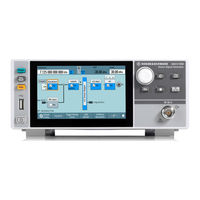Rohde & Schwarz SMCVB-K709 Manuals
Manuals and User Guides for Rohde & Schwarz SMCVB-K709. We have 2 Rohde & Schwarz SMCVB-K709 manuals available for free PDF download: User Manual
Rohde & Schwarz SMCVB-K709 User Manual (853 pages)
Vector Signal Generator
Brand: Rohde & Schwarz
|
Category: Inverter
|
Size: 18 MB
Table of Contents
-
-
Welcome19
-
Key Features19
-
What's New20
-
-
Vnc72
-
-
Required Options104
-
-
General Settings105
-
Settings105
-
Data Source108
-
Filter Settings112
-
Data List Editor116
-
References125
-
About ARB136
-
Required Options136
-
ARB Settings141
-
-
Settings
142 -
Usage
175-
CLOCK: Frequency175
-
SAMPLES: Samples179
-
Required Options189
-
Required Options220
-
-
-
Mode224
-
Carrier Spacing225
-
Clipping225
-
Power Reference226
-
Signal Period226
-
Clock Rate228
-
File Size228
-
Output File228
-
Output Settings228
-
-
-
Gain Start232
-
Gain Step232
-
Phase Start232
-
Delay Start233
-
Delay Step233
-
Phase Step233
-
Settings233
-
Settings
256 -
-
Detect/Scan262
-
Device ID263
-
Remote Channel263
-
RF Path263
-
Overview266
-
General Settings269
-
[:Source
270-
Peak Level271
-
General Settings273
-
Connected Device274
-
Remote Command274
-
Remote Command275
-
Required Options280
-
AWGN Block284
-
AWGN Settings285
-
[:Source
287-
Bit Rate288
-
Reference Mode288
-
E B /N289
-
Required Options294
-
Required Options298
-
Required Options303
-
Required Options312
-
About Sweep Mode325
-
About List Mode329
-
-
-
Current Level334
-
Mode334
-
Retrace335
-
Shape335
-
Dwell Time336
-
Spacing336
-
Reset Sweep337
-
Trigger Slope337
-
-
General Settings341
-
Current Index342
-
Dwell Time Mode342
-
Mode342
-
State342
-
Run Mode343
-
Trigger Slope343
-
List Editor347
-
Attenuator353
-
User Correction355
-
-
Sense ●
372-
Sensor Mapping373
-
Sensor Settings373
-
State373
-
Use Frequency of373
-
Zero373
-
Filter374
-
Frequency374
-
Aperture Time375
-
Filter Length375
-
Timeout375
-
Enable Logging376
-
Required Options380
-
Protecting Data406
-
Reference406
-
Required Options435
-
LAN Interface479
-
Network Settings494
-
LXI Settings501
-
QR Code501
-
References535
-
Common Commands540
-
Preset Commands545
-
Format Subsystem565
-
Hcopy Subsystem567
-
Automatic Naming569
-
Kboard Subsystem572
-
Output Subsystem572
-
Source Subsystem602
-
System Subsystem758
-
Status Subsystem780
-
TEST Subsystem784
-
UNIT Subsystem787
-
Notifications789
Advertisement
Rohde & Schwarz SMCVB-K709 User Manual (913 pages)
Vector Signal Generator
Brand: Rohde & Schwarz
|
Category: Portable Generator
|
Size: 21 MB
Table of Contents
-
-
Welcome20
-
Key Features20
-
What's New21
-
Videos23
-
-
Vnc74
-
Common Settings100
-
Required Options106
-
-
General Settings107
-
Settings107
-
Data Source110
-
Filter Settings114
-
Data List Editor118
-
References127
-
Required Options137
-
About ARB138
-
ARB Settings143
-
-
Settings: State
144-
Waveform Info145
-
Clock Frequency146
-
HDD Streaming146
-
Test Signal Form147
-
-
CLOCK: Frequency177
-
SAMPLES: Samples180
-
Required Options191
-
Required Options221
-
-
Section 6
224-
Set to Default224
-
Mode225
-
Carrier Spacing226
-
Clipping226
-
Frequency226
-
Power Reference227
-
Signal Period227
-
Clock Rate229
-
File Size229
-
Output File229
-
Output Settings229
-
-
Section 7
256-
Auto Connect257
-
Display257
-
Connector Name258
-
Direction258
-
I/Q Connection259
-
Instrument Name259
-
Overview266
-
General Settings269
-
General Settings273
-
Required Options280
-
AWGN Block284
-
AWGN Settings285
-
-
[:Source
287-
Bit Rate288
-
Reference Mode288
-
E B /N289
-
Required Options294
-
Required Options298
-
Required Options303
-
Required Options312
-
About Sweep Mode326
-
About List Mode329
-
List Editor347
-
Attenuator353
-
User Correction355
-
Required Options394
-
Protecting Data420
-
Reference420
-
Required Options449
-
LAN Interface502
-
Network Settings518
-
HUMS Settings525
-
QR Code535
-
LXI Settings536
-
References571
-
Common Commands575
-
Preset Commands580
-
Format Subsystem611
-
Hcopy Subsystem612
-
Automatic Naming615
-
Kboard Subsystem617
-
Output Subsystem618
-
Source Subsystem649
-

